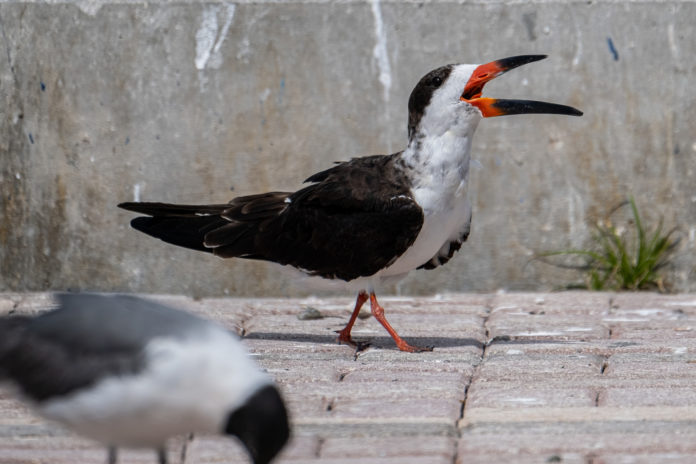I didn’t go down to Mallory Square to see the skimmers. I went down to see the protest.
A group of liveaboard boaters from Key West Harbor were understandably worried about what a new law recently passed in the state legislature would do to their way of life.
It wasn’t a huge crowd, probably 30 people, a lot of them in T-shirts that said, “I Am Not a Derelict.” The law, when it is enacted, will require liveaboards who aren’t at a permanent mooring to move their vessels every 90 days. It’s said to be out of environmental concern, but it’s a little unclear how forcing boats to reset their moorings on a regular basis will do much more than tear up seagrass and create less stable moorings, resulting in more boats breaking loose in bad weather, creating havoc all around.
A few people spoke, including City Commissioner Sam Kaufman, who did what he could to redirect some people’s anger in a more effective direction.
Periodically through all of this I would hear it – the bark of a black skimmer.
I used to be under the illusion that I was alone in thinking black skimmers sounded kind of canine, but in 1936 a biologist named R.C. Murphy described them as “unworldly … aerial beagles hot on the scent of aerial rabbits” – which is edifying, but kills any notion of originality on my part.
Skimmers are kind of amazing, oddly beautiful, purpose-built birds. They were calling from over at the wharf. It used to be you’d see them there periodically, when maybe a day or two had passed without a cruise ship tying up. But with the lack of 1,000-foot vessels mooring there on a regular basis, it’s become a pretty reliable spot to see them.
After the protest, I went over and sat on the curb and stared at them for a while, because it is a little harder to think that everything is going to hell in a handbasket in the presence of black skimmers.
They’re not terns, but they are tern-like. If you look down on them from above they’re black. From below, they are white. It can appear as if they’re wearing a hoodie. The color change between their hemispheres is sharp and in their face occurs low on the cheek, sometimes giving them the appearance of being eyeless. Their eyes, which are there, have vertical slits, like a cat’s, possibly to help them deal with the glare off the water, possibly to help them see better at night. A wide band of orangey-red at the base of their bill keeps them from being monochrome, a bit of visual drama that also colors their feet.
Their most dominant feature is their bill, which makes up about a fifth of their length. From the side it looks thick and bulky, like a carrot. From straight on, it is thin as a blade. Their lower mandible is about an inch longer than their upper. Their Latin name – Rynchops niger – translates roughly to “black billface.”
Their bill is at the core of their whole operation.
A skimmer feeds by feel, dragging its lower mandible through the water. When it hits a fish the upper mandible snaps shut and it gulps down the fish. To accommodate this, they have long, skinny wings and a light wing load, allowing them to fly slowly and smoothly, with an otherworldly buoyancy that seems derived from a limited immunity deal with the laws of gravity.
They tend to feed in the calmest of waters.
It’s hard to settle on one visual metaphor. They look like a tailor running his scissors through a bolt of cloth, a farmer plowing a field, a calligrapher’s pen moving across parchment, a needle hitting a groove on a spinning vinyl record. One of their Spanish names is Cortaguas, or cutwater, which I think is a better fit.
While they tend to feed alone, or in groups of two or four, they usually cluster in their off hours. At Mallory there were about 50 of them, spread out across the pavers, surrounded by a crowd of 100 or so laughing gulls, who took the higher ground of the concrete curb.
Most birds sleep standing, often with their heads tucked back under a wing. And black skimmers will do that. But they also have that big bill, which gets heavy, and sometimes they will lie with their chin flat on the ground in front of them, like a dog. And sometimes when they do this, they will sprawl, and even sleep listing to the side, their wings splayed out in an ungainly manner, looking, to someone who has stared at a lot of sleeping birds, like they are dead, or ill, or damaged. But they are not. They are just sleeping.
Sitting there watching them, I noticed several were standing with their bills wide open, as if caught in a 10-minute yawn. Often, when you see birds doing this, it’s a way to thermoregulate, to rid their body of excess heat. But it was cool out, and windy, and it didn’t seem a necessity.
Maybe it was just a comfortable way to switch up their posture. It might also have been a way to make themselves look bigger. Several times I saw laughing gulls wandering close to their personal space, and the skimmers with open mouths would kind of shunt them away as if with a very dull pair of scissors. And once I saw a pair of them who did not get along both open their mouths and feint at each other, like two people squaring off to fight with chopsticks.
There never was much heat or anger in it. It was just everyone trying to stake some space in the world.

























